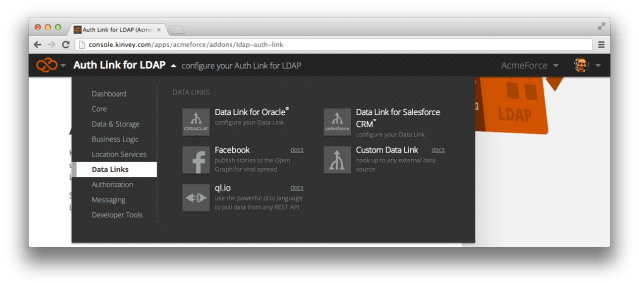On one day, the software runs on complex hardware systems behind the firewall. The next it is software operating as a service in the cloud. And so explains Kinvey, a startup that today announced a way for enterprise customers to scrap their hand stitched, back-end systems running middleware for a service that does it for them in a cloud environment.
The new Kinvey For Enterprise back-end as a service (BaaS) platform allows developers to build mobile apps that can authenticate users and securely read, edit and publish data to and from enterprise data sources, such as Salesforce.com CRM and Oracle.
Before, middleware ran inside the data center, often on proprietary software that locked customers into one vendor. Data now needs to pass freely between data centers and public cloud services across any number of applications. In these “heterogeneous,” environments, mobile apps changing everything. A company may use Sharepoint and Salesforce.com. To get that data into one mobile app they can’t rely solely on the provider’s API. They need a mobile SDK to get that data and feed it into the app.
Sravish Sridhar is the founder and CEO at Kinvey. He said developers need their back-end systems synchronized with front end development. Before, companies built these overly complex service oriented architectures (SOA) with web services that connected an API facing out to the web. That became a holy mess and the solutions providers made an absolute killing stitching it all together.
Companies like IBM, SAP and Antenna Software made a fortune in this market. They controlled the middleware through complex SOA environments.
That’s where companies like Kinvey enter the picture by providing a cloud-based mobile SDK so companies can connect data sources such as Salesforce.com and Sharepoint.
“Mobile developers building rich apps have different needs than their web development counterparts,” said Bret Siarkowski, vice president of research and development with Game Show Network, a Kinvey customer who I interviewed over email this week. “In the world of mobile, the libraries are the new abstraction layer for the mobile developer, not the API. We don’t want to re-create common functionality including data syncing, online-offline support, user management and data security. Having proven libraries that take care of such functionality is very efficient for development.”
Forrester Research Analyst Michael Facemire wrote in a recent report that BaaS vendors take the challenges that middleware vendors address and provide cloud-based solutions that feature no vendor lock-in, cloud scalability to handle mobile success, a proxy to a multitude of third-party services and cloud tooling.
Siarkowski says BaaS solidifies the process for building mobile apps.
“The biggest advantage with BaaS, is that it helps us future-proof our mobile strategy through a self-service platform,” Siarkowski said. “We can pick any SDK to build apps with and can therefore build native or hybrid user experiences based on the needs of the app. We can then tie any data or authentication system to our apps, allowing our developers to iterate and innovate quickly. We’re able to avoid creating silos for each app, which saves us time and money.”
Without getting too gung ho, this is a super crowded market as Facemire pointed out in a post last year.
They include StackMob, Usergrid, Appcelerator, FeedHenry, Sencha.io, Applicasa ,Parse, CloudMine , CloudyRec , iKnode, yorAPI, Buddy and ScottyApp.
That is not to mention Windows Azure use of Dropbox, which it uses as a back-end for syncing and updating websites.

